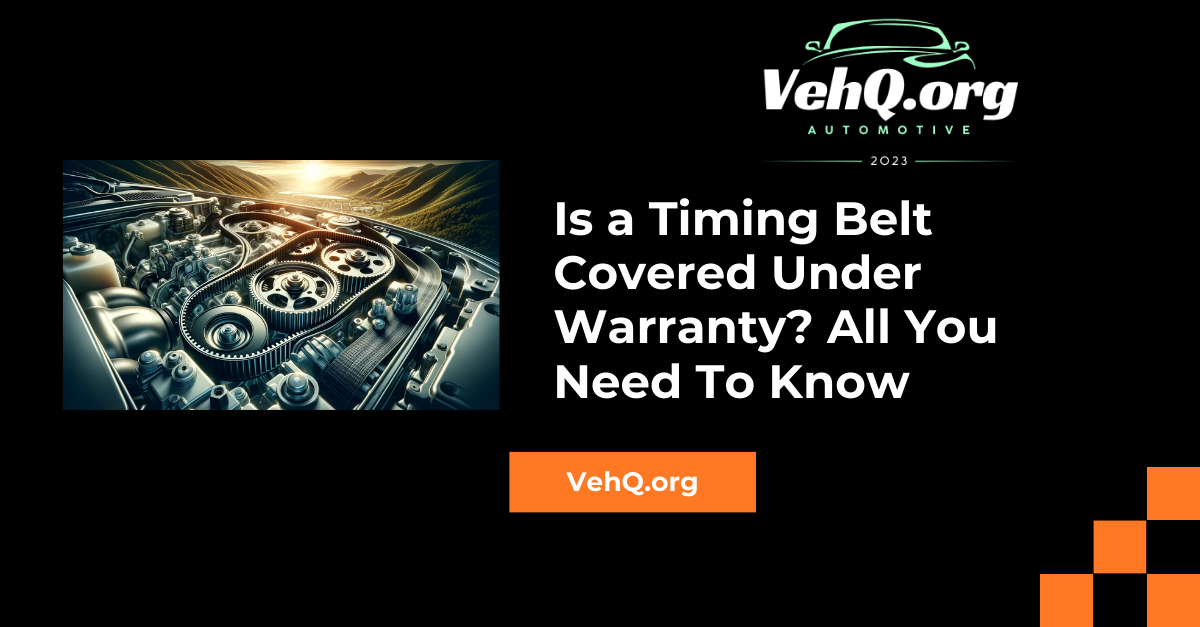When it comes to vehicle maintenance and unexpected repairs, understanding what is covered under your car’s warranty can save you a significant amount of money and stress.
One critical component that often raises questions regarding warranty coverage is the timing belt. Here’s a comprehensive guide to help you understand whether a timing belt is covered under warranty.
What Does the Timing Belt Do?
A timing belt is a crucial part of an engine that ensures the synchronization of the camshaft and crankshaft. This synchronization allows the engine’s valves to open and close at the proper times during each cylinder’s intake and exhaust strokes.
If a timing belt fails, it can cause severe engine damage, which is often expensive to repair.
There are Different Manufacturer Warranties
Most new vehicles come with a manufacturer’s warranty that covers major components for a specific period or mileage. However, timing belts often fall into a gray area. Generally, manufacturer warranties are categorized into:
Bumper-to-Bumper Warranty
This type of warranty covers almost all parts of the vehicle but often excludes wear-and-tear items like timing belts. Typically, these warranties last for about three years or 36,000 miles.
Powertrain Warranty
This warranty covers the engine, transmission, and drivetrain components. Some powertrain warranties might include the timing belt if it fails within the coverage period, but this is not always guaranteed.
Powertrain warranties usually last longer, often up to five years or 60,000 miles, with some extending up to 100,000 miles depending on the manufacturer and vehicle model.
Is a Timing Belt Covered Under Warranty? Coverage Variability

To keep things simple; Whether a timing belt is covered under warranty depends on the manufacturer’s policy and the specific terms of your vehicle’s warranty. Generally, timing belts are considered wear-and-tear items and may not be covered unless they fail prematurely within the warranty period.
Here are a few examples to illustrate this variability:
Chevrolet powertrain warranty
Typically, Chevrolet’s powertrain warranty covers the timing belt, but it is essential to check the specific terms related to your vehicle model and year.
Volkswagen Warrenty
Some Volkswagen models have experienced issues where timing belts were not covered under warranty, especially if considered a wear-and-tear item or if the failure occurred outside the recommended service interval (TDIClub Forums).
Hyundai
Hyundai often includes the timing belt in its powertrain warranty, especially if the failure happens within the warranty period and is due to a defect in materials or workmanship.
Extended Warranties
Extended warranties or vehicle service contracts can provide additional coverage beyond the manufacturer’s warranty. However, like manufacturer warranties, these often exclude routine maintenance items such as timing belts.
Some extended warranties might offer coverage for timing belt failure if it results in significant engine damage, but this depends on the policy terms.
Common Exclusions
Wear and Tear – Timing belts are generally considered wear-and-tear items that require periodic replacement as part of regular vehicle maintenance. Most warranties will not cover the replacement of a timing belt as a maintenance item.
Scheduled Maintenance – Warranties typically do not cover failures due to neglecting the recommended maintenance schedule. If a timing belt fails because it was not replaced at the manufacturer’s recommended interval, this may not be covered.
Pre-existing Conditions – If the timing belt shows signs of wear or damage before the warranty period starts or if the issue was known and not addressed, coverage might be denied.
Ensuring Coverage On the Timing Belt
To ensure that your timing belt is covered under warranty:
- Read the Warranty Terms: Carefully review the warranty booklet provided with your vehicle. Pay close attention to the sections detailing what is covered and what is excluded.
- Follow Maintenance Schedules: Adhere to the manufacturer’s recommended maintenance schedule for your vehicle. This often includes timing belt inspections and replacements at specified intervals.
- Keep Records: Maintain detailed records of all maintenance and repairs performed on your vehicle. These records can be crucial if you need to make a warranty claim.
- Ask Questions: If in doubt, contact your vehicle’s manufacturer or dealer to clarify whether the timing belt is covered under your specific warranty.
Is a Timing Belt a Maintenance Item?
Yes, a timing belt is considered a maintenance item in most vehicles. This means it is subject to regular inspection and replacement as part of the vehicle’s routine maintenance schedule. The timing belt is crucial for the proper operation of the engine, ensuring that the camshaft and crankshaft are synchronized. If it fails, it can cause severe engine damage, leading to costly repairs.
Volvo “Park Assist System Temporarily Unavailable”: What You Need to Know
veh q
What to Know About Timing Belt Maintenance
The recommended interval for timing belt replacement varies depending on the vehicle make and model. Generally, timing belts should be replaced every 60,000 to 100,000 miles.
Some manufacturers may have different intervals, so it is essential to consult your vehicle’s owner’s manual or contact the manufacturer for the specific recommendation for your car.
Signs of a Worn Timing Belt
- Engine Misfires: If the timing belt is worn or stretched, it can cause the engine to misfire, affecting performance and fuel efficiency.
- Rattling Noise: A loose or damaged timing belt can produce a rattling noise from the front of the engine.
- Oil Leaks: Oil leaking from the timing belt cover often indicates a failing timing belt or related components.
Importance of Timely Replacement
Replacing the timing belt at the recommended intervals is crucial to prevent engine damage. A broken timing belt can lead to the valves and pistons colliding, which can severely damage the engine and result in costly repairs.
Cost of Repairing or Replacing a Timing Belt
The cost of repairing or replacing a timing belt varies depending on the vehicle make and model, labor rates, and additional parts that may need to be replaced simultaneously, such as the water pump.
Replacement Cost
Labor Costs: The labor cost for replacing a timing belt can range from $300 to $1,000. This is due to the labor-intensive nature of the job, as accessing the timing belt often requires removing several engine components.
Parts Costs: The cost of the timing belt itself can range from $20 to $200. However, it is common to replace other components like the water pump, tensioners, and pulleys, which can add $100 to $500 to the total cost.
Total Cost: On average, the total cost for a timing belt replacement ranges from $500 to $1,500.
A valuable discussion; What is Covered Under a Car Warranty?
The extent of this coverage depends on the type of warranty and the terms provided by the manufacturer or third-party warranty provider. Here’s a comprehensive overview of what is typically covered under different types of car warranties:
Types of Warranties
01. Bumper-to-Bumper Warranty
- This is the most comprehensive type of warranty, often covering nearly all components of the vehicle, excluding wear-and-tear items. It typically includes:
- Electrical components
- Air conditioning system
- Audio system
- Suspension
- Safety systems
- These warranties usually last for three years or 36,000 miles, though the exact duration can vary by manufacturer.
03. Powertrain Warranty
- Focused on the core components that make the car move, this warranty covers:
- Engine
- Transmission
- Driveshafts
- Differentials
- Other internal parts of the engine and transmission
- Powertrain warranties often have longer coverage periods, such as five years or 60,000 miles, with some extending up to 10 years or 100,000 miles.
03. Corrosion/Rust Warranty
- Covers repairs or replacements of rusted-through sheet metal parts. This warranty is usually longer, often lasting five years or more.
04. Emissions Warranty
- Covers specific emissions-related components such as the catalytic converter and engine control module. The coverage period varies but is often mandated by federal regulations to last for at least eight years or 80,000 miles.
Common Exclusions
Most warranties exclude certain items and conditions:
- Wear-and-Tear Items: Components like brake pads, tires, wiper blades, and filters are typically not covered.
- Maintenance Services: Oil changes, fluid replacements, and other routine maintenance tasks are excluded.
- Damage from Accidents or Misuse: Any damage resulting from collisions, vandalism, racing, or off-road use is generally not covered.
- Alterations: Installing non-factory parts or making modifications can void the warranty coverage.
- Cosmetic Issues: Issues related to interior upholstery, paint, and trim are not covered under most warranties.
Extended Warranties
After the original factory warranty expires, many owners opt for an extended warranty, which can offer similar coverage for an additional period. These can include:
- Major Vehicle Systems: Similar to bumper-to-bumper coverage.
- Roadside Assistance: Towing, rental car reimbursement, and trip interruption benefits.
- Wear-and-Tear: Some extended warranties cover parts that wear down over time.
The Dangers of a 12V Battery Critical Charging Fault; Must Read
veh q
Conclusion
Understanding the specifics of what is covered under your car’s warranty can help you avoid unexpected repair costs and maintain your vehicle properly. Always read the fine print of your warranty document to know the exact coverage and exclusions. For extended peace of mind, consider purchasing an extended warranty tailored to your driving needs and habits.
Conclusion
The coverage of a timing belt under warranty depends on several factors, including the type of warranty, the manufacturer’s policies, and adherence to maintenance schedules. While some warranties may cover the timing belt if it fails due to a defect, most do not cover it as a routine maintenance item. To avoid unexpected expenses, ensure you understand your warranty terms and keep up with the recommended maintenance for your vehicle.



One Comment